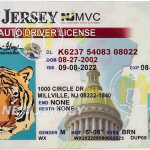In the digital – age landscape of 2025, the issue of fake IDs has become a significant concern across various sectors. Whether it’s for accessing age – restricted services, fraudulently obtaining documents, or engaging in illegal activities, fake IDs pose a threat to security, privacy, and the proper functioning of society. In response to this challenge, AI – driven image recognition technology has emerged as a powerful tool in the realm of ID card verification.
The Growing Problem of Fake IDs in 2025
The advancement of printing and digital manipulation technologies has made it easier for individuals to create counterfeit IDs. In 2025, the sophistication of fake IDs has reached new heights. Criminals are using high – end printers, scanners, and software to replicate the look and feel of genuine identity documents. These fake IDs can be used to bypass age – related restrictions in bars, clubs, and for purchasing alcohol and tobacco. They are also misused in financial transactions, where fraudsters try to open accounts or obtain credit using false identities.

Moreover, the rise of online services has added another layer of complexity. Many platforms require identity verification for user registration, and fake IDs can be used to create fake accounts, leading to issues such as identity theft, spam, and cyber – crime. The traditional methods of ID verification, such as visual inspection and simple barcode or magnetic – stripe reading, are no longer sufficient to detect the increasingly sophisticated fake IDs in circulation.
How AI – driven Image Recognition Works for ID Card Verification
AI – driven image recognition for ID card verification operates on a combination of deep learning algorithms and computer vision techniques. When an ID card is presented for verification, the system first captures an image of the card using a high – resolution scanner or camera. The captured image is then processed through a series of steps.
- Pre – processing: The image is enhanced and cleaned to improve the quality. This may involve tasks such as noise reduction, contrast adjustment, and skew correction. The goal is to make the text, images, and other features on the ID card as clear as possible for further analysis.
- Feature Extraction: The system identifies and extracts key features from the ID card image. These features can include text (such as the name, date of birth, and ID number), photographs, logos, and security features like holograms or watermarks. Deep learning models, such as convolutional neural networks (CNNs), are trained to recognize these features accurately.
- Pattern Recognition: Once the features are extracted, the system compares them against a database of genuine ID card patterns and templates. It looks for similarities and differences to determine if the presented ID is authentic. For example, the font style, size, and placement of text on a genuine ID are compared to the ID in question. The same goes for the quality and characteristics of the photograph and security features.
- Decision – making: Based on the results of the feature extraction and pattern recognition steps, the AI system makes a decision on the authenticity of the ID card. If the features match the expected patterns within an acceptable tolerance level, the ID is considered genuine. Otherwise, it is flagged as potentially fake.
Benefits of AI – driven Image Recognition in ID Card Verification
One of the primary benefits of using AI – driven image recognition in ID card verification is its speed. In 2025, where rapid service delivery is crucial, these systems can quickly analyze an ID card and provide a verification result in a matter of seconds. This is much faster than manual verification methods, which can be time – consuming, especially when dealing with large volumes of IDs.

Accuracy is another significant advantage. AI algorithms are trained on vast datasets of genuine and fake IDs, allowing them to learn the细微 differences between real and counterfeit documents. As a result, they can detect even the most subtle signs of forgery, such as small variations in the texture of a hologram or the alignment of text. This high level of accuracy helps to reduce false positives and false negatives, ensuring that only genuine IDs are accepted and fake ones are identified.
AI – driven systems also offer scalability. They can be easily integrated into various verification processes, whether it’s at a single point – of – sale terminal, a large – scale event, or an online platform. This scalability makes it possible to deploy ID verification solutions across different industries and settings, from hospitality and retail to government agencies and financial institutions.
Challenges in Implementing AI – driven Image Recognition for ID Card Verification
Despite its many benefits, implementing AI – driven image recognition for ID card verification is not without challenges. One of the main issues is the quality of the input images. Poor lighting, low – resolution cameras, or damaged ID cards can result in images that are difficult for the AI system to analyze accurately. Ensuring that the imaging equipment is of high quality and well – maintained is essential to overcome this challenge.
Another challenge is the constantly evolving nature of fake ID technology. As fraudsters develop new techniques for creating counterfeit IDs, AI systems need to be updated regularly to recognize these new threats. This requires continuous research and development to keep the AI algorithms up – to – date with the latest forgery methods.
Privacy is also a concern. ID card images contain sensitive personal information, and ensuring the security and privacy of this data is crucial. AI – driven verification systems must have robust security measures in place to protect against data breaches and unauthorized access.
Common Problems and Solutions
Problem 1: Low – quality Images
Low – quality images can lead to inaccurate verification results. This can be caused by factors such as poor lighting, a low – resolution camera, or a damaged ID card.
Solution: Use high – quality imaging equipment with proper lighting. Ensure that the camera has a sufficient resolution to capture all the details on the ID card. For damaged ID cards, try to enhance the image using pre – processing techniques. If the damage is too severe, request a replacement ID from the relevant authority.
Problem 2: New Types of Fake IDs
Fraudsters are constantly coming up with new ways to create fake IDs, and AI systems may not be able to recognize them immediately.
Solution: Continuously update the AI algorithms with the latest data on fake ID patterns. Collaborate with law enforcement agencies and other relevant organizations to stay informed about the latest forgery techniques. Conduct regular research and development to improve the accuracy of the AI system in detecting new types of fake IDs.
Problem 3: False Positives
A false positive occurs when a genuine ID is flagged as fake. This can cause inconvenience to the cardholder and may lead to unnecessary delays.
Solution: Fine – tune the AI algorithms to reduce the rate of false positives. Set appropriate tolerance levels during the pattern recognition process. Implement a manual review process for IDs that are flagged as potentially fake, especially if they are from trusted sources or have been verified in the past.
Problem 4: False Negatives
A false negative is when a fake ID is wrongly accepted as genuine. This can pose a significant security risk.
Solution: Increase the training data for the AI system, especially data on difficult – to – detect fake IDs. Regularly evaluate the performance of the AI system and adjust the algorithms if the rate of false negatives is too high. Implement multiple layers of verification, such as combining image recognition with biometric authentication, to increase the overall security of the verification process.
Problem 5: Privacy Concerns
There are concerns about the privacy of the personal information contained in ID card images.
Solution: Implement strict data protection policies and security measures. Encrypt the ID card images during storage and transmission. Limit access to the data to authorized personnel only. Ensure that the AI – driven verification system complies with relevant privacy regulations, such as GDPR (General Data Protection Regulation) or CCPA (California Consumer Privacy Act), depending on the jurisdiction.
Problem 6: Compatibility Issues
Integrating AI – driven image recognition systems into existing verification processes may face compatibility issues with legacy systems or software.
Solution: Conduct a thorough assessment of the existing infrastructure before implementing the new system. Choose an AI – driven solution that is compatible with the current technology stack. Work with software developers to ensure seamless integration. Provide training and support to the staff to help them adapt to the new verification process.
Problem 7: Cost of Implementation
Implementing an AI – driven image recognition system for ID card verification can be costly, especially for small – and medium – sized businesses.
Solution: Look for cost – effective solutions that offer the necessary functionality. Consider cloud – based AI services, which can reduce the need for expensive hardware and software installations. Calculate the long – term benefits of the system, such as reduced fraud and improved efficiency, to justify the initial investment. Explore government subsidies or grants that may be available for security – related technology implementations.
Fake ID Pricing
unit price: $109
| Order Quantity | Price Per Card |
|---|---|
| 2-3 | $89 |
| 4-9 | $69 |
| 10+ | $66 |



